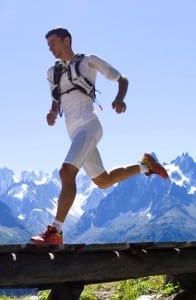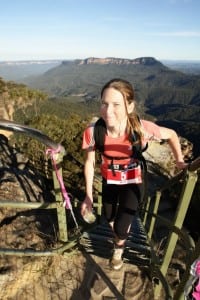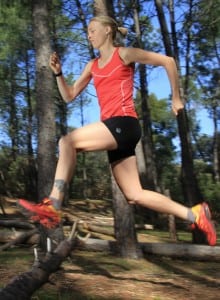 On the morning of Saturday, May 14, an army of foreigners will wage war against Australian champions in the Blue Mountains outside of Sydney. Their battlefield is a narrow one. It’s but a 100-kilometer long strip of dirt. Along the way, the 800 combatants, or trail runners, will climb the equivalent of 1500 stories. In the end, only two – a man and a woman – will be champions. Will the reigning Australians defend their crowns or the onslaught of fleet footed foreigners prevail leaving new victors to carry the day at The North Face 100? To bring us up to speed, we’re lucky to have the input of Roger Hanney, an Australian who spoke with many of the top contenders. Here’s his story.
On the morning of Saturday, May 14, an army of foreigners will wage war against Australian champions in the Blue Mountains outside of Sydney. Their battlefield is a narrow one. It’s but a 100-kilometer long strip of dirt. Along the way, the 800 combatants, or trail runners, will climb the equivalent of 1500 stories. In the end, only two – a man and a woman – will be champions. Will the reigning Australians defend their crowns or the onslaught of fleet footed foreigners prevail leaving new victors to carry the day at The North Face 100? To bring us up to speed, we’re lucky to have the input of Roger Hanney, an Australian who spoke with many of the top contenders. Here’s his story.
South African Ryan Sandes could not have been more appropriately named. The 29-year-old has not just trekked but raced, and won, races through the Amazon Jungle and across four of the planet’s harshest deserts, including the Sahara and even Antarctica. With each race held over a week’s time, ‘the Sandman’ was still racing up to 100k at a time in temperatures ranging from well below freezing to more than 115F, and fully self-supported. This meant that apart from water, runners have to carry everything they need for a week, in packs weighing up to 40 pounds.
Though a genuinely tough, uniquely talented athlete who has run fast, heavily laden, through desert sands and snow, Sandes is not even favoured to win. The real buzz is around Kilian, the young Spanish runner so famous that one name will do. By tradition, though, this Spaniard from Catalan has three – his own, his father’s, and his mother’s.
Kilian Jornet Burgada, is about five and a half feet tall, 55kg, and utterly unstoppable. At 23 years of age he has already turned the endurance world on its head. Aged just 20 he won the 103-mile mountain race that traverses three countries and doubles as the World Championship of trail ultras. Then he won it again. Last year in the second season of online webisodes, ‘Kilian’s Quest’, he ran from the Atlantic to the Mediterranean, 800km across the icy peaks of the Pyrenees, in just 8 days. That should be a typo but it isn’t – yes, he ran 100km per day for 8 days.
Working his joints differently half the year, Kilian is also a ‘skimo’ or ski mountaineering champion. To picture skimo, imagine running a marathon as hard as you possibly can. Now, imagine doing that in ski boots, through thick snow and across glaciers, breathing thin air at 4,000 meters – twice Australia’s highest peak – and temperatures below zero. The week before leaving for Sydney, Kilian won such a race, finishing ahead of more than a thousand competitors.
But he returns to the trail, because, he says, trail running permits trail running is the single sport offering the “adrenalin of downhills, pleasure of mountains and the endurance sport.” And he knows most of what’s worth knowing about adrenalin. He punctuated 2010 with a World Record run of less than five and a half hours up Mount Kilimanjaro – normally a week-long trek – then descended in half the time.
Active on ski slopes for the last 6 months, he hasn’t really run in all that time. His message to other entrants is simple, “Go slowly at the race, please!” A broad smile is evident in his tone, “No, I think the most important is to take pleasure and in the mountains, every day we discover new things. I’m very happy to discover this country and very excited to meet the Australian trail running community.”
Reigning champion and co-holder of the course record, Andrew Lee expects that the international guests will take away some soreness, memories of beautiful scenery, and a sense of Aussie camaraderie, “if they don’t get too far ahead!” He knows too well how the course treats winners. Last year, he and Stu Gibson dueled for 9 hours, down gullies, around cliffs, over fallen trees and up giant hills. Realizing that neither could have run as hard as they did without the other, in the final minutes they joined hands to cross the line together, setting a new course record of less than ten hours along the way.
A contractor for the Australian Army, family man, and 2-time winner, Lee has fond memories of kangaroos skipping alongside as he trained on his own, racing past wildfires, and running countless miles through the Australian bush. When he gets to the bottom of 850 steep and uneven stairs on Saturday having already run 70km, his attitude “as they’re not going to get out of the way, is to go up them quickly as possible and get it over and done with” and deal with the cramping later.
While Lee has competed overseas, racing in air so thin that championship half-marathon times read like marathon times, this is the first time he’ll be facing such a prestigious international team on Australian trails. And he’ll be doing it without his dueling partner from last year.
Gibson is missing out due to a recently recovered complex tendonitis – the occasional price of running through whatever pain may come – but predicts that his and Lee’s record will be smashed by an hour. This year he has been recovering from such an unlikely and unusual injury that the Australian Institute of Sport has been using him as a case study – another measure of just how much the gap between trail ultra runners and mainstream endurance sport has narrowed.
Of course, running out of sight does have some unique advantages. “It’s not often you get the chance to ‘race’ over and through a UNESCO World Heritage Site,” says Gibson, “so that’s pretty special.”
Another man who knows about culturally significant environs is Damon Goerke. Part of Australian adventure racing crew Team Blackheart, Goerke holds the record as fastest Aussie to run the Kokoda Track. Champion wheelchair athlete and icon of personal strength, Kurt Fearnley, crawled the track in 9 days, comparing every day to a complete marathon. Experienced trekkers cover the 96km in 5 to 7 days. Goerke ran it in 19 ½ hours.
“The reality is that the Kokoda Track is as tough, rugged, remote and demanding as everyone says it is,” reports Goerke, “and I am sure it is in a hell of a lot better condition now than 70 years ago! There were several times I just wanted to stop and have a good think about what I was trying to do, but there’s no other way out but to finish so you have to keep going.”
He’s flattered that some have pointed him out as the dark horse contender for the event, but plans only to run as hard as he can for as long as it takes. He also disagrees about just how much faster the demanding mountain course can be run. “I don’t think people are giving Stu and Andy’s performance and record time last year enough respect, they were pretty quick,” said Goerke. “I don’t think I will personally see much of Kilian after the first bend. But I think the Aussie ladies run some pretty quick times and should give all the overseas guns a run for their money.”
The main ‘Aussie lady’ is Sydney sensation Beth Cardelli. [UPDATE: Cardelli withdrew to focus on Western States.] A very busy member of Berowra Bushrunners, Cardelli has been building her training toward Western States, a 100 mile endurance race in the US, widely regarded as one of the benchmark events in ultramarathon. But first she is hoping for a spirited defense of her women’s North Face crown. Weighing less than a heavy thought, Cardelli knows that her nimble size is an advantage over long, hard terrain. But she also embraces the mental muscle as underrated.
“In ultra trail running it helps to have a strong mind that allows you to focus on the terrain ahead without getting overwhelmed with the thought that you have many more km’s ahead which could take 24 hours to cover,” she said. And she should know. Widely regarded as Australia’s toughest trail race, in 2010 she ran 175km on the Great North Walk – most of the way from Newcastle to Sydney – in just over 24 hours. With temperatures hovering close to 105F for most of the daylight hours, she still powered on into the night, tearing close to an hour off the women’s course record.
Not yet known to the wider Australian public, Cardelli has repeated this feat and similar across New South Wales, Victoria, and Tasmania, setting record and second fastest ever times over every distance from 64km and up. If she’d worn a watch for last year’s North Face 100, she might have grabbed that women’s record too – instead of missing it by a mere 2 minutes.
No space for such minor oversights this year – a troop of women every bit as tough as, maybe even tougher than the guys have flown in to try to chase Cardelli down. Her two main rivals come from opposite sides of the planet.
A blonde German personal trainer, Julia Böttger is marketably spunky. [UPDATE: Böttger withdrew prior to the race.] Like Kilian, Böttger has had her own 800km adventure – running from her home in Munich to the French mountains where all ultrarunners dream of testing themselves against the world’s best. Over 3 weeks, carrying all her own equipment and food through brutal weather that turned to harsh cold and driving rain, Böttger ran on.
“Most of the people were just really happy to see me doing this run over the Alps. Like being a girl on her own,” she recalls, “not racing but enjoying running.” Averaging her vertical ascent throughout this mountainous adventure, she climbed the equivalent of 700 flights of stairs per day – a staggering 41km, or 4 ascents of Everest – packed into just 21 days.
No less impressive is American Devon Crosby-Helms. With her own stack of ultrarunning achievements her most recent was to run the fastest known time from one rim of the Grand Canyon to the other, and back again. Although this record stood briefly, broken by a friend a few days later, she brings real experience and strong legs to what may well be the fastest women’s trail ultra field yet assembled in Australia.
Like Gibson, she recognizes the challenge of getting the details right for endurance – part of the reason why she has recently released her own book, How to have a Devon Day: a Runner’s Guide to a Breakthrough Performance. No doubt she’ll be practicing what she preaches in the Blue Mountains.
Roger Hanney is a Sydney-based writer and superslow superfreak. His type 1 diabetic ultrarunning ass will be tweeting live and legging it from The North Face 100 @AROCultra.
Call for Comments
Other top men’s contenders include Sebastien Chaigneau, François D’Haene, and Grant Guise [added]. For the women, there’s Nerea Martinez, Jen Segger [added], and Lisa Tamati. Are there others we missed? We’ll add them here based on your comments.
Who do you think will win the TNF 100?
The race has world class competition this year. What do you think it will take to make this a staple of the elite ultra calendar, a la Western States, Miwok, and UTMB?
Have you ever dreamed of racing in Australia?


